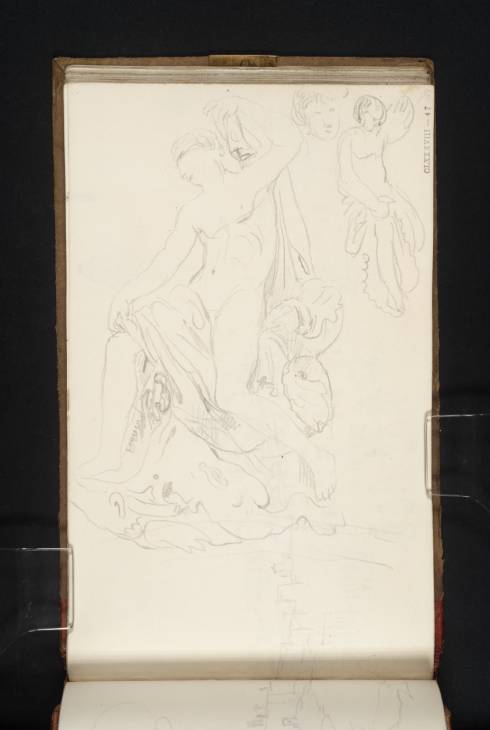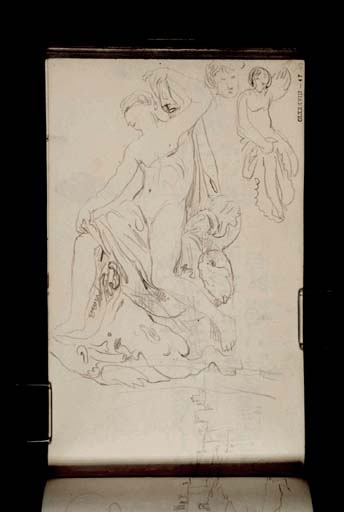Joseph Mallord William Turner Sketches of the Statue of 'Jonah' in the Chigi Chapel, Santa Maria del Popolo, Rome 1819
Image 1 of 2
Joseph Mallord William Turner,
Sketches of the Statue of 'Jonah' in the Chigi Chapel, Santa Maria del Popolo, Rome
1819
Joseph Mallord William Turner 1775–1851
Folio 48 Recto:
Sketches of the Statue of ‘Jonah’ in the Chigi Chapel, Santa Maria del Popolo, Rome 1819
D16240
Turner Bequest CLXXXVIII 47
Turner Bequest CLXXXVIII 47
Pencil on white wove paper, 189 x 114 mm
Inscribed by John Ruskin in red ink ‘47’ top right, ascending right-hand edge
Stamped in black ‘CLXXXVIII 47’ top right, ascending right-hand edge
Stamped in black ‘CLXXXVIII 47’ top right, ascending right-hand edge
Accepted by the nation as part of the Turner Bequest 1856
References
1909
A.J. Finberg, A Complete Inventory of the Drawings of the Turner Bequest, London 1909, vol.I, p.559, as ‘Santa Sabina and other buildings on the Aventine; also two antique figures and a head’.
1984
Cecilia Powell, ‘Turner on Classic Ground: His Visits to Central and Southern Italy and Related Paintings and Drawings’, unpublished Ph.D thesis, Courtauld Institute of Art, University of London 1984, pp.113, 131, 148, 426, reproduced fig.47, as ‘Sketches of Raphael’s Jonah in the Chigi chapel, S. Maria del Popolo’.
1987
Robert E. McVaugh, ‘Turner and Rome, Raphael and the Fornarina’, Studies in Romanticism, no.26, Fall 1987, p.386 and note 47.
1987
Cecilia Powell, Turner in the South: Rome, Naples, Florence, New Haven and London 1987, pp.[40], 52, 61 note 54, reproduced p.[41] pl.44, as ‘Sketches of Raphael’s Jonah, Chigi chapel, S. Maria del Popolo’.
2011
Nicola Moorby, ‘Turner’s Sketches for “Rome from the Vatican”: Some Recent Discoveries’, Turner Society News, no.115, Spring 2011, pp.4, 9 note 6.
These three sketches represent Jonah, a marble statue of the Old Testament character located in the Chigi Chapel in the Church of Santa Maria del Popolo. Like the chapel itself, the sculpture was designed by Raphael although was ultimately executed by his pupil, Lorenzo Lotto, also known as Lorenzetto (1490–1541). It still stands in the same position as in Turner’s day, in a niche on the left-hand side of the altar. Cecilia Powell has argued that the aspect on entering the chapel is unsatisfactory since the the legs appear foreshortened. In order to find the best compositional arrangement therefore, Turner must have adopted the viewpoint at the far side of the altar, below the pendant sculpture of Elijah by Bernini. Another sketch of the statue inscribed ‘Jonas’, can be found in the Remarks (Italy) sketchbook (see Tate D16855; Turner Bequest CXCIII 85a).
During the nineteenth century the work was still believed to be the sole example of Raphael’s skill as a sculptor, even though it had in fact been established that it had been executed by a pupil from a model by the master.1 Samuel Rogers, who visited Rome in 1814, wrote in his journal entry for 15 December, ‘Chapel of “Agostin Chigi amico suo caro” the work of which was superintended by Raphael; who died before it was finished. The cieling [sic] is in mosaic from his designs ... & the statue of Jonas must have been modelled by him, it is so full of sweetness. The head, says Canova, is that of the Antinous.’2 John Gage has linked Turner’s knowledge of the statue with his homage to Raphael, the large oil painting Rome, from the Vatican exhibited 1820 (Tate N00503).3 Gage has suggested that the reclining statue in the foreground of the picture, possibly of a river god, is intended to represent the Renaissance master’s skill in various aspects of the arts, including sculpture. However, Robert McVaugh has argued that the sculpture in the painting in fact may represent, Day, a work by Michelangelo from the Medici Chapel, Florence.4
At the bottom of the page is a continuation of the landscape on the opposite sheet of the double-page spread, see folio 47 verso (D16239; Turner Bequest CLXXXVIII 46a).
Verso:
Blank
Blank
Nicola Moorby
September 2008
How to cite
Nicola Moorby, ‘Sketches of the Statue of ‘Jonah’ in the Chigi Chapel, Santa Maria del Popolo, Rome 1819 by Joseph Mallord William Turner’, catalogue entry, September 2008, in David Blayney Brown (ed.), J.M.W. Turner: Sketchbooks, Drawings and Watercolours, Tate Research Publication, December 2012, https://www


